North Carolina War Between the States Sesquicentennial
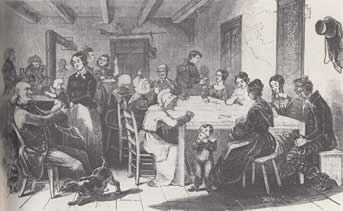
The North Carolina People in 1860
The Economic Diversity of North Carolinians:
“Diversity of economic status is indicated by the 1860 Census report on occupations in North Carolina.
[There] were 87,025 farmers, 63,481 laborers, 27,263 tradesmen, 7,436 professional workers,
3,479 merchants, 1,626 clerks, 1,936 teachers, 1,308 manufacturers, and 133 planters.
The upper economic group of planters, merchants and professional men, and manufacturers
composed only 6 per cent of the total. Agriculture was the chief occupation, and North Carolina was
predominantly a State of small farms. Only 311 farms were larger than one thousand acres, while
46,300 were less than 100 acres each and 2,050 were smaller than ten acres. The average for
the whole State was 316 acres.
Guion Johnson, In Antebellum North Carolina, truly says: “If occupations, land, and slaves be taken
as indices of wealth, it is evident that the average per capita wealth in the State was not large. There
were few overgrown estates, and the majority of the inhabitants lived upon the produce of their own labors.”
E.J. Hale, writing in 1853, declared: “Everybody here knows that very few of the present
slaveowners . . . inherited their slaves or other property, . . many began life with nothing,
and have made their own fortunes. The man with wealth who inherited it, is the exception.
The poor man who made his fortune, is the almost universal rule.”
Though North Carolina was a slave State, the majority of North Carolina whites never owned slaves
at any time. The percentage of slaveholding families in the State was 31 per cent in 1790, 26.8 per cent
in 1850, and about 28 per cent in 1860. Of every hundred slaveholding families, 46 owned less than
5 slaves each; 71 owned less than 10; 88 owned less than 20; and 2 owned as many as 50.
In the entire State, according to the United States Census of 1860, only 133 planters owned 100
or more slaves, 15 owned 200 or more, 4 owned 300 or more, and not one owned as many as 500.
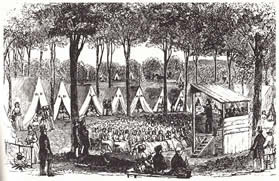
Social Stratification:
The highest social class, the gentry, or planter aristocracy, comprised the owners of large plantations
and more than twenty slaves, as well as the most prominent public officials, professional men,
and business leaders. It numbered about 6 per cent of the total white population.
Much larger than the gentry was the middle class consisting of small slaveholding farmers owning
fewer than twenty slaves, small merchant and manufacturers, and lesser public officials and
professional men, numbering about 20 to 25 per cent of the white population.
Still larger was the third class of yeoman and mechanics – independent, small, non-slaveholding farmers,
naval-stores workers, miners, mechanics, tradesmen, overseers, and some of the farm tenants –
numbering 60 to 65 per cent of the total white population.
At the bottom of the social pyramid of the whites were the “poor whites,” a group numbering
somewhere between 5 and 10 per cent of the white people, consisting of landless tenants and
laborers who had failed in the struggle of life because if incapacity, laziness, improvidence, or disease.
Many of them lived in shacks on the outskirts of towns and villages.
A writer in a Raleigh newspaper in 1855 said: “Many hundreds and thousands of poor men with
families . . . existing upon half-starvation are congregated especially about our towns and villages . . .
doomed to drag out a miserable and useless existence.” Their inheritance was poor, and many
of them suffered from malaria, hookworm, pellagra, and other diseases about which medical
science of the time was largely or completely ignorant. One English observer referred to the
Southern “poor whites” as “the most degraded people of Anglo-Saxon stock in the world.”
Most of the North Carolina whites were poor, but did not belong to the “poor white” class,
which was held in contempt even by many of the slaves.
The term “poor white” connoted more than poverty.
Beneath the four classes of whites were two classes of Negroes – free Negroes and Negro slaves.
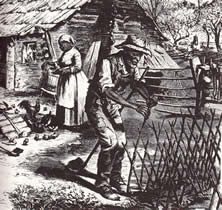
Free Negroes: Only Maryland and Virginia in the South and Pennsylvania, New York and Ohio
in the North had more than the 30,463 free Negroes in North Carolina in 1860. The chief source
of the free Negro population was manumission, or the granting of freedom to individual slaves by
masters and the legislature. But legal restrictions made manumission difficult after 1830,
when manumitted slaves were required to leave the State within ninety days.
Other sources were purchases of freedom by the slaves themselves, births by free Negro and white
mothers, and immigration, though both race-mixing and free Negro immigration were prohibited by
law. The rate of increase of free Negroes ranged from 34 to 46 per cent for each decade from 1790
to 1830, but dropped sharply thereafter. Seventy per cent of the free Negroes in North Carolina in
1860 were mulattoes. There was some concentration of free Negroes in the towns and cities,
but most of them were scattered through the rural slaveholding areas.
Gradually the free Negro was legally restricted in, or deprived of, his freedom of moving about,
associating with slaves, keeping arms, trading, teaching, preaching, and voting. He could not appear
as a witness against a white man or compel white debtors to pay their debts to him. However,
he retained in North Carolina more rights than in most of the other Southern States. He had the
rights of habeas corpus, trial by jury, and the ownership, transfer, devise and descent of property.
The free Negroes were considered to have a bad influence on the slaves. Among the free Negroes
there was some indolence, poverty, squalor, immorality, disease, and petty criminality, but many
were industrious, self-sufficient, and respectable as skilled artisans, businessmen, and farmers.
In 1860, there were 3,548 free Negroes who owned property, fifty three of them in amounts
ranging from $2,500 to $36,000 each.
A few free Negroes owned slaves – in 1790, 25 owned a total of 73 slaves; in 1830,
190 owned 629 slaves; but in 1860, there were only 8 free Negro slaveholders, with a total
of only 25 slaves. In 1830, Gooden Bowen of Bladen County and John Walker of
New Hanover owned 44 slaves each, and in 1860 James Sampson of New Hanover
owned property valued at $36,000 [and Henry Sampson owned five slaves].
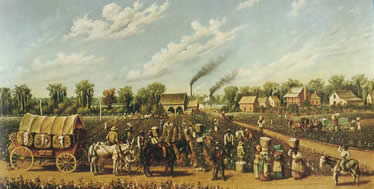
Negro Slaves:
The Negro slaves constituted the lowest social class in North Carolina. Numbering in 1860 nearly
one-third (331,059) of the total population and increasing in numbers more rapidly than the whites,
they varied in density from a small minority in the mountain and other non-staple areas to more
than one-third of the population in the cotton and tobacco counties of the Piedmont and the East.
Only five counties – Granville, Wake, Edgecombe, Halifax and Warren – had more than 10,000
each, the highest ratio of slaves to whites being in the last three, with Warren County
having a slave population of 68 per cent of its total.
Because of the smaller number of large plantations and slaveholdings, North Carolina’s slave
regime was perhaps milder and more patriarchal than that in most of the Southern States. Of the
seven major slaveholding States, only Louisiana had fewer slaves in 1860 – and that by only
about 4,000; of the eleven seceding States in 1860-1861, North Carolina ranked eighth
in the ratio of slaves to whites.
Fewer plantations were owned by absentee landlords and managed by hired overseers than in
most slave States. The more intelligent and faithful Negroes worked as slave-drivers, personal
and household servants – nurses, cooks, seamstresses, maids, and bodyguards, or as skilled
artisans. But the vast majority of the slaves worked as field hands under the supervision of
master or overseer, usually “from sun to sun,” but occasionally only a nine or ten-hour stint,
tilling an average of about twenty acres per hand, depending on the nature of the crop
grown – less for tobacco and more for cotton.
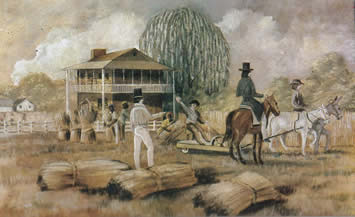
Because of the closing of the foreign slave trade in 1808 by act of Congress, and the growing
demand for slaves in the cotton areas of Alabama, Mississippi and Louisiana during their
“flush times,” the price of a “prime field hand” in North Carolina rose from about $300
in 1804 to $800 in 1840 and to $1000 in 1860.
Self-interest as well as humanitarian considerations demanded that the master supply
sufficient food and clothing to conserve the strength, health, and happiness of the slave
so that he could work regularly and hard. Though marriage of slaves was not recognized
by law, masters encouraged slave “marriages,” families, and home life.
Life was easier, happier, and more profitable for the master who won the regard of his slaves by
kind treatment and reasonable tasks. The oppressed slave could always retaliate against a cruel
or unreasonable master by taking to the woods for a few days. The returning or recaptured runaway
would receive a whipping but also perhaps relief from the grievances which had caused his
master to suffer the loss of the slave’s labor.
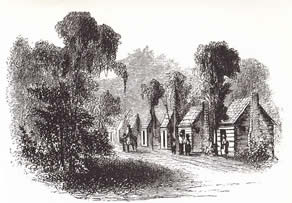
Legally, the master was free to use any punishment of discipline, except murder, that was
necessary to secure complete obedience; but more efficacious than harsh punishment were
rewards, such as permission to plant patches of land for vegetables and crops and raise pigs
and chickens, presents for good behavior and work, and considerable
freedom at night and on holidays and week-ends.
Hunting, swimming, fishing, dancing, games, and visits afforded some recreation for the slaves.
Cruel masters and refractory slaves were the exception. Most of the slaves appeared well-contented
and well-cared for, and often there was real devotion between masters and slaves.
Laws Relating to Slaves:
The system of laws relating to slaves, known as the slave code, protected the rights of the owner in
his valuable property; restricted the mobility and activities of the slave; sought to minimize the
possible mental and moral corruption and discontent of the slaves by protecting them from education,
preaching, and the writings of free Negroes and antislavery agitators; and provided the machinery
for effective white control in emergencies.
The slave code was made more harsh and restrictive after 1830 because of the public concern
caused by Nat Turner’s bloody insurrection in near-by Southampton County, Virginia, in 1831.
The missionary effects of Northern abolitionists . . . also aroused concern.
In practice, the lives of slaves were regulated more by the will of the masters than by law. Though the
law frowned upon the education of slaves and prohibited slaves from teaching and preaching to them,
some masters provided a rudimentary education for those having unusual ability in order to enhance their
usefulness on the plantation, and many masters considered it their duty to provide religious instruction –
sometimes on the plantation by the master himself or by a minister, sometimes in the churches of the
whites where the Negroes sat in their allotted place, and sometimes in separate Negro churches.
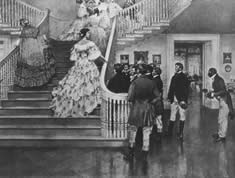
Social Life of the Planter
Social life among the white classes in North Carolina was largely rural. Some of the gentry lived in
stately homes in groves at some distance from the roads or rivers. The planter was busy most of the
time with the complex business of operating the plantation, and the mistress was busy looking
after her home, managing the supplies of food for the plantation population, and caring for the slave
families who lived in cabins in the near-by slave quarters.
Ebenezer Pettigrew, a successful planter, wrote: “A Plantation to be well managed should
never be left but at very short intervals.” If a matter of life and death required it, the owner
should go away, “but not otherwise.”
Though small in numbers, the gentry or planter class was looked up to by other social groups.
Some of the more intelligent, industrious, and thrifty merchants and farmers of the middle class were
able to rise to the planter class. It had great influence in county and State politics, and many
planters held high political office. It was the dominant class in North Carolina politics
before 1835 and in the Democratic party after 1835.
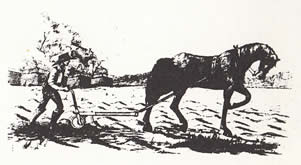
Social Life of the Common People
Less wealthy than the gentry, the middle class lived in smaller and plainer houses, often worked
on their farms with their slaves, and led a simpler life. But some of them worked hard, expanded
their business, educated their children, achieved political office, and were able
to climb the social and economic ladder.
The yeoman class of small farmers and laborers, though a majority in all sections of the State,
was predominant in the Piedmont and Mountain regions. Owning no slaves, they lived in
log houses of one or two rooms, poorly furnished, and had simple food and clothes. The father and
sons worked the small farm; the wife and daughters did all the housework and often helped
work in the fields. Though life was rather monotonous and there was little time or money for
recreation and travel, they now and then had good times hunting and fishing or at church,
camp meetings, weddings, parties, public hangings, horse races, shooting matches,
and political meetings. The men sometimes gathered at militia musters, at the county
seat during court week, and at country store, church, mill and tavern.
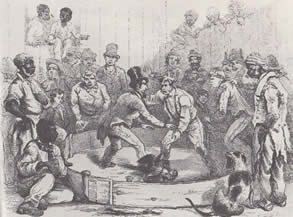
More than any other class, the yeoman typified the population of North Carolina.
(North Carolina, The History of a Southern State, Lefler & Newsome, UNC Press, 1954, pp. 396-402)
Sources:
Close to the Land, North Carolina 1820-1870, Thomas H. Clayton, UNC Press, 1983
Copyright 2014, North Carolina War Between the States Sesquicentennial Commission